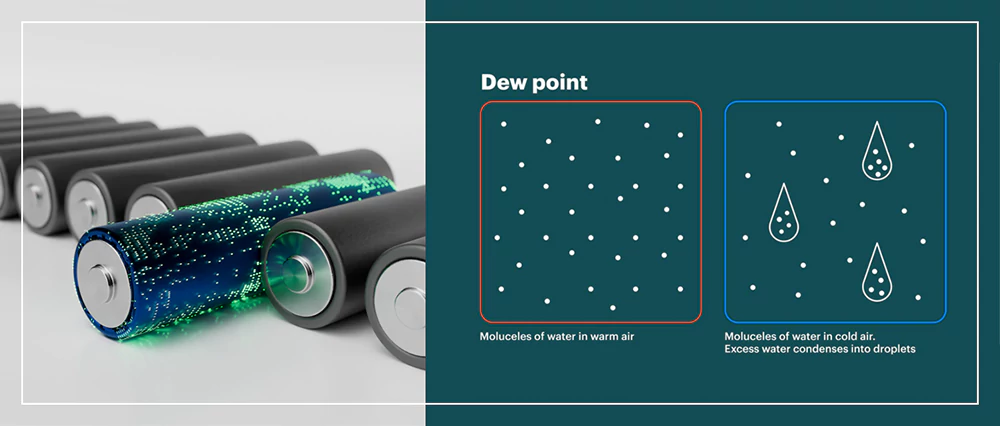O ponto de orvalho é a temperatura na qual a umidade se condensa. Quando o teor de vapor de água no ar permanece inalterado e a pressão do ar é mantida constante, a temperatura na qual o ar é resfriado até a saturação é chamada de temperatura do ponto de orvalho (Td), ou ponto de orvalho, abreviadamente. Também pode ser entendida como a temperatura na qual o vapor d'água e a água atingem o equilíbrio. A diferença entre a temperatura real (t) e a temperatura do ponto de orvalho (Td) indica quão próximo o ar está da saturação. Quando tï¼Td, o ar está insaturado, quando t=Td, está saturado, e quando tï¼td, está supersaturado.
|
Relativo tamanho |
Água conteúdo de vapor no ar |
|
Ambiente temperatura temperatura do ponto de orvalho |
Insaturado |
|
Ambiente temperatura = temperatura do ponto de orvalho |
Saturado |
|
Ambiente
temperatura |
Supersaturado |
As baterias de íons de lítio têm requisitos muito rigorosos requisitos de umidade ambiental durante o processo de fabricação, principalmente porque a perda de controle de umidade ou controle de engrossamento terá sérios efeitos adversos no eletrólito. O eletrólito é o transportador do íon transmissão em baterias de íons de lítio. É composto por sais de lítio e solventes orgânicos. É a garantia para que as baterias de íons de lítio obtenham vantagens como alta tensão e alta energia específica.

A umidade excessiva terá sérios efeitos adversos efeitos no eletrólito:
1. Deterioração eletrolítica
O o eletrólito é o portador da transmissão de íons na bateria, composto de sal de lítio e solvente orgânico. O eletrólito desempenha o papel de conduzir íons entre os eletrodos positivos e negativos da bateria de lítio, e é a garantia para que a bateria de íons de lítio obtenha vantagens como alta tensão e alta energia específica. Durante o processo de enchimento da bateria, o a umidade deve ser inferior a 1% e a bateria deve ser selada assim que possível após o enchimento para evitar que o interior da bateria entre em contato com o ar. Se a umidade for muito alta, o eletrólito reage com a umidade para gerar vestígios de gases nocivos, que têm um efeito adverso sobre o ambiente da sala de enchimento; isso também afetará a qualidade do próprio eletrólito, resultando em baixo desempenho da bateria.
2. Capacidade da bateria diminui
A primeira capacidade de descarga da bateria diminui à medida que o conteúdo de água na bateria aumenta. Excesso de água o conteúdo danificará os componentes eficazes do eletrólito e consumirá íons de lítio, causando reações químicas irreversíveis de íons de lítio no eletrodo negativo da bateria. À medida que os íons de lítio são consumidos, a capacidade da bateria diminui.
3. Aumento interno resistência
Como o conteúdo de água da bateria aumenta, a resistência interna tende a aumentar. Durante o uso do bateria, a resistência interna é pequena, de modo que uma grande descarga de corrente pode ser realizada e a carga da bateria estiver alta. Se a resistência interna for grande descarga de corrente grande não pode ser realizada e a energia da bateria é relativamente baixo. O teor excessivo de água afetará a qualidade do filme SEI na bateria de lítio, afetando assim a resistência interna do bateria.
4. Pressão excessiva dentro da bateria
A água reage com o LiPF6 no eletrólito para gerar gases nocivos. Quando há muita água, a pressão dentro do a bateria aumenta, fazendo com que a bateria se deforme sob estresse. Se for um bateria do telefone celular, ela aparecerá como uma concha protuberante. Quando o interno a pressão for mais alta, a bateria corre o risco de explodir e a explosão fará com que o eletrólito respingue e os fragmentos da bateria podem facilmente ferir pessoas.
5. Vazamento de bateria
Além de gerar gás, o LiPF6 no eletrólito reage com a água para produzir ácido fluorídrico, um ácido altamente corrosivo que pode corroer as peças metálicas dentro da bateria, causando a bateria eventualmente vazará. Se a bateria vazar, o desempenho da bateria cairá rapidamente e o eletrólito também corroerá a máquina do usuário.
Resumir:
O eletrólito, o material do eletrodo positivo e o material do eletrodo negativo são muito sensíveis à água. Para garantir a qualidade da bateria, a umidade na oficina e no porta-luvas deve ser rigorosamente controlada. Em particular, alguns processos importantes, como secagem de células de bateria, enchimento de eletrólito, vedação, etc., devem ser realizados em um ambiente com baixa umidade inferior a 1% para evitar a entrada de umidade no eletrólito. Neste momento, a mudança no valor da temperatura do ponto de orvalho é necessária para refletir a flutuação da umidade. Geralmente, a temperatura do ponto de orvalho deve ser controlada abaixo de -45°C, ou até mais seca.
TOB NEW ENERGY fornece uma linha completa de baterias de íons de lítio, baterias de íons de sódio, supercapacitores, baterias de estado sólido e soluções de baterias de lítio-enxofre .